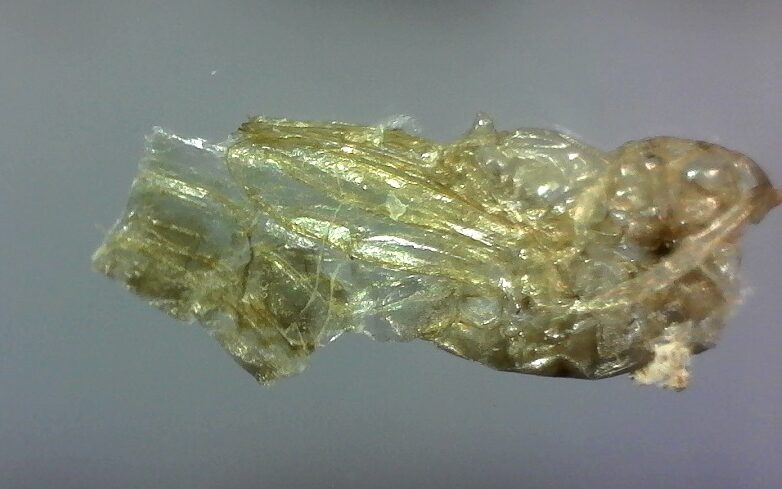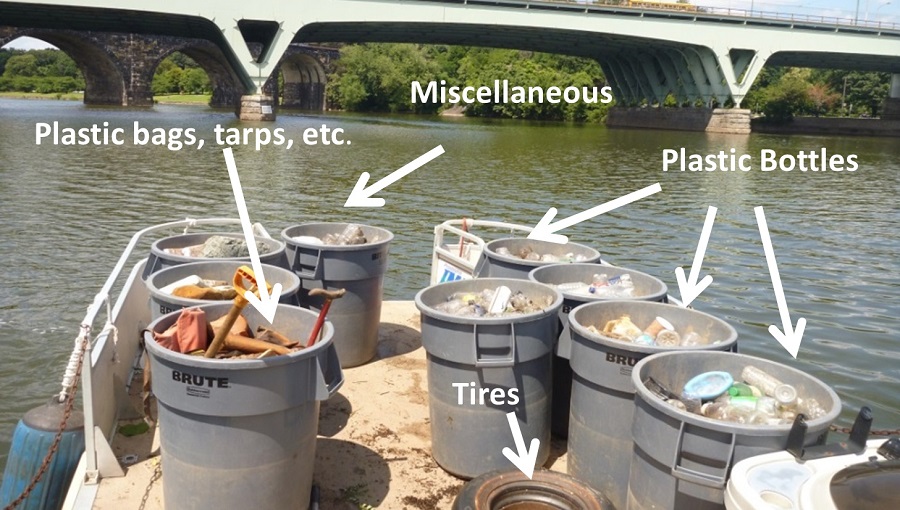Although research is still being conducted on the health effects of microplastics, PWD is proactively addressing the occurrence of these tiny particles in our waterways.
About Microplastics
Plastics are everywhere in our lives, found all over the world in everything from bottles and bags to makeup and clothing. Microplastics are tiny pieces of plastic, often invisible to the naked eye, that come from these larger objects when they are broken down by sunlight, oxygen, or friction.
People are exposed to microplastics when they breathe air and dust, drink liquids, and eat food. Our bodies naturally flush out the vast majority of microplastics, but research has shown that some extremely small particles can remain in our systems.
It is unclear whether microplastics pose a danger to human health. Health risks from microplastics depend on the level of exposure, the type of plastic, and the size of the particles. Research suggests certain types of plastics are harmful to fish and animals when they build up in the organs or bloodstream over time.
We may not be able to eliminate microplastics from the environment, but we can try to limit our exposure to them.
As such, PWD has taken several steps to reduce plastic in the rivers that provide the city of Philadelphia with its drinking water.
Remember, the primary sources of microplastics are the larger plastic items that we use every day!
Help keep our rivers and streams free from plastic litter!
Philadelphia Water Department Actions
- The most effective tool in reducing microplastics is to control pollution due to macroplastics – the larger plastic items such as bottles, bags, tires, and packaging that litter rivers and streams and break down into microplastic particles.
- PWD operates skimming vessels – boats that “skim” floating litter, or floatables, from the surface of the Delaware and Schuylkill rivers and provide access to the shore for manual collection of litter and trash, including plastics. On average, each small skimming vessel collects approximately 1.1 tons of plastic per year.
- The 39-foot skimming boat R.E. Roy operates on the Delaware and Schuylkill rivers, collecting large debris that includes plastics and tires. The R.E. Roy collects more than 2 tons of recyclable materials per year. Plastics make up 75% of the total volume of recyclable material collected.
- PWD’s maintenance of the sewer system removes a substantial amount of microplastics that enter our system via the city’s ~72,000 stormwater drains and sanitary (plumbing) lines. It is estimated that more than 1,000 tons of plastics are removed each year through PWD’s sewer maintenance and other operations units.
- Our Waterways Restoration Team removes large debris and bulk wastes from our creeks and rivers, helping to control plastics pollution and prevent localized flooding.
- PWD regularly organizes and supports volunteer cleanups throughout the city. Be the first to know when PWD-supported cleanups are happening in the city by signing up for our event alerts!
Storm drains are not trash cans!
PWD’s Storm Drain Marking Program helps remind your neighbors to keep them – and our waterways – clean.
- The vast majority of microplastics in the water supply are removed at the drinking water and wastewater treatment plants through filtration. However, some extremely small particles remain. PWD is always investigating advanced treatment technologies that may eliminate microplastics and other impurities.
- While microplastics are a global issue, we still strive to learn about the occurrence and effects of microplastics here in Philadelphia. PWD’s Bureau of Laboratory Services conducts research to better understand microplastics.
- Since 2017, PWD has collected and characterized microplastics from the city’s rivers and streams. Our analysts have developed expertise in collecting and testing water for the presence of microplastics.
- A 2019 PWD case study focused on so-called “flushable” wet wipes. Even though these wipes may flush down your toilet, they can clog wastewater treatment plants, and their small fibers are considered microplastics that could end up in the river.
- PWD’s future research will focus on measuring the amount of microplastic contamination, looking at spatial and seasonal trends, and characterizing microplastics in different waterways.
Frequently Asked Questions
Does PWD generate microplastics?
No. However, they are inevitably transported through PWD’s system. Microplastics are everywhere in the environment, and when your job is to collect, clean, and distribute water throughout a large city, microplastics are likely to be present in that process.
How does trash get into PWD’s stormwater and wastewater collection systems?
Water is a great conveyor – it can transport floating litter downstream or deposit it on a riverbank. Litter on the ground can easily end up in PWD’s stormwater and wastewater collection pipes when it rains.
Rain carries trash and plastics with it as it drains into stormwater inlets. Once underground, the stormwater will continue to carry the trash through large pipes until it is released into our rivers and streams with the collected stormwater.
Some areas of the city have underground pipes that transport stormwater and wastewater together. In these combined sewer areas, litter carried into the pipes via stormwater will end up at one of Philadelphia’s three water pollution control plants, where it is removed early in the multi-step cleaning process.
Does PWD remove microplastics at its treatment plants?
Yes, but some microplastics can be so tiny that many make their way through water and wastewater treatment plants without being detected and ultimately end up in our rivers and streams.
Philadelphia’s water treatment plants, like many others, draw in river water and send it through a multi-step cleaning process so it can provide drinking water to your home. During the typical drinking water treatment process, it is estimated that up 55%i of microplastics can be removed, a percentage that PWD may be able to increase with modifications to treatment technologies and operations.
Studies show on average 88%ii of microplastics are removed during the wastewater treatment process, with estimates ranging from 78% to 100% removaliii at plants designed similarly to Philadelphia’s three water pollution control plants.
i Wang et al., (2020). Occurrence and removal of microplastics in an advanced drinking water treatment plant (ADWTP). Science of The Total Environment, 700(134520), DOI: 10.1016/j.scitotenv.2019.134520.
ii Iyare et al., (2020). Microplastics removal in wastewater treatment plants: a critical review. Environmental Science Water Research & Technology. 6(2664), DOI: 10.1039/d0ew00397b.
iii Tang & Tony Hadibarata (2021). Microplastics removal through water treatment plants: Its feasibility, efficiency, future prospects and enhancement by proper waste management. Environmental Challenges, 5(100264), DOI: 10.1016/j.envc.2021.100264.
Will the City’s plastic bag ban help reduce microplastics?
Any reduction in the use of plastics will ultimately cut down on the amount of microplastics present in our environment.
Can a home water filter remove microplastics?
Common types of filters, such as those that attach to your faucet or may be inside of a water pitcher, may remove some microplastics. These filters have different size pores and thus the size of the particles they can remove vary. Similarly, the size and shape of microplastics may vary, with particles ranging from 0.001 to 5 millimeters. (For reference, the average human hair is 0.07 millimeters thick, and the point of a sharpened pencil is 1 mm thick.) Ultimately the smaller microplastics are going to make their way through the filter just as they may make their way through a drinking water treatment plant.
Does bottled water contain more microplastics than tap water?
As you may have guessed, there are more microplastics in bottled water than in tap water. A 2019 study found that those who drink bottled water may be ingesting an additional 90,000 microplasticsiv annually—that’s more than 22 times the amount than those who drink tap water. Additionally, plastic bottles are responsible for approximately 50% of the trash in Philadelphia’s rivers. Drinking tap water helps control microplastics consumed through drinking water and the amount of plastics pollution in the environment!
iv Cox et al., (2019). Human Consumption of Microplastics. Environmental Science and Technology. 53(12), 7068–7074. DOI: 10.1021/acs.est.9b01517
Are microbeads considered microplastics?
Microbeads are a category of microplastics. Microbeads, or tiny solid beads of plastic, are typically used as exfoliants or scrubbers in facial cleansers and toothpastes. Microbeads are designed to go down your drain, but they may be too small to be removed during wastewater treatment.
In 2015, Congress passed the Microbead Free Waters Act, which prohibits the manufacturing, packaging, and distribution of rinse-off cosmetics and non-prescription personal care products, including toothpastes, that contain microbeads. As a result, the manufacturing and delivery of these products stopped in 2019.
However, this ban does not account for personal care products that are not designed to wash off immediately (e.g., face creams, sunscreens, and cosmetics). You can reduce the amount of microbeads entering wastewater treatment plants by being a conscientious consumer and keeping these products from going down your drain.
Is my drinking water tested for microplastics?
There are currently no standardized laboratory methods for measuring the amount of microplastics in drinking water. However, the scientists at our labs are working to develop techniques and expertise for the detection and identification of different types of microplastics in our waterways. This exploratory research has not yet been applied to PWD drinking water.
What can I do to help reduce microplastics in the environment?
Experts agree that the best way to control microplastics is by controlling them at the source. You can make some changes to your routine to reduce the amount of plastics in the environment before they release microplastics.
Avoid single-use plastics and try to get as much use as possible from the plastic products you already own. Simply put: reduce, reuse, and recycle.
Everyday efforts may include using reusable grocery and produce bags, using refillable water bottles, and rinsing and recycling plastics. You may want to volunteer or organize a local clean up to remove plastic litter from the environment.

